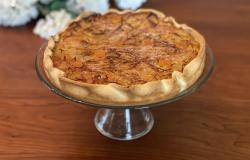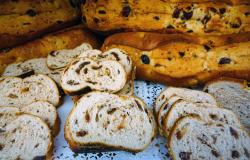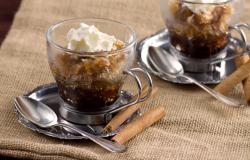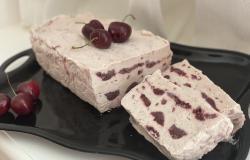Panzerotti con Ceci: Sweet Chickpea Baked Ravioli
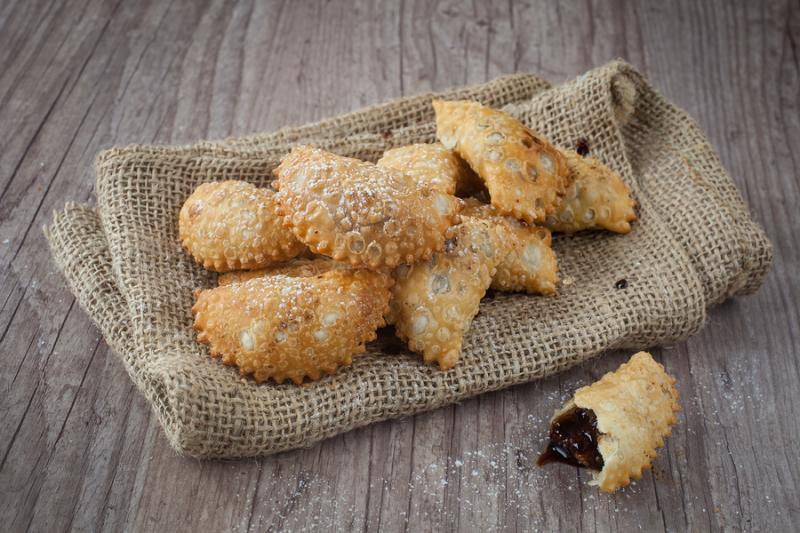
Almost every region of Italy has its own sweet dessert ravioli with variations in fillings, shapes and cooking methods. Like Abruzzo’s caggiunitte, fried ravioli filled with pureed chestnuts, chocolate, espresso, rum and ground nuts or Marche’s cauciuni, baked half-moon shaped ravioli, filled with sweetened pecorino cheese. In Rome and other parts of the Lazio region dessert ravioli are filled with ricotta that’s been sweetened with either jam or sugar and in Sicily there’s a unique half-moon shaped baked dessert called ‘mpanatigghie filled with ground beef and chocolate.
In Puglia and Basilicata, ravioli called panzerotti, which means “tummy” in the regional dialect, are irresistible bundles of sweet crisp dough filled with mashed chickpeas and jam. They date back centuries and are especially popular during the Christmas holidays. Chickpeas aren’t a typical dessert ingredient but should be, as when pureed they are velvety on the tongue and add a pleasing denseness to sweet fillings. Panzerotti are traditionally eaten warm, sprinkled with powdered sugar or dipped in honey, or cold dipped in local mosto cotto or saba.
Usually, ravioli can be tricky to make, because you have to get the dough very thin and seal them carefully since they’re going to be dashed about in rapidly boiling water like tiny ships in a storm. But because these ravioli are baked rather than boiled, you can make them thicker and don’t have to worry about them opening. A very easy to work with dough!
Cook’s Tip: I learned a fabulous tip from Franca Artusi, the 72 year old spry grandmother from Basilicata who taught me this recipe. Instead of using a bunch of flour on the work surface to keep the dough from sticking, spread out a yard or so of clean white cotton canvas cloth, available at a fabric stores. It works miracles. The dough doesn’t stick or dry out from the extra flour. Plus-- and this is a big deal for me—clean-up is much easier. No little stuck on bits of flour all over the place. Just toss the cloth in the washing machine when you’re done and enjoy dessert!
Another Cook’s Tip: Bake the panzarotti in batches so that you’re baking one batch, while assembling the second. This way, you get to sample your efforts after just 25 minutes!
Makes about 4 dozen
For the filling:
Process the chickpeas through a food mill until you get a nice thick, smooth paste. Then mix in the jam and liqueur to taste. Stir in the zest and cinnamon to taste, and then add sugar or honey, if you like. Once you have tasted it and are happy with the flavor, then mix in the egg. You can make the filling several days ahead. Refrigerate until ready to use.
For the dough:
Sift the flour, sugar and salt onto a clean work surface and make a well in the center. Heat the wine in a saucepan or in the microwave. Pour the oil and 1/4 cup of the wine into the well and incorporate the flour, a little at a time, until dough forms. Add warm water, a little at a time, if the dough feels tough. Knead the dough until smooth. Put into a plastic bag or wrap in plastic wrap
To assemble:
Preheat oven to 350 degrees F. Line 2 or 3 baking sheets with parchment paper.
Spread out a large clean cotton cloth onto a work surface for assembling and cutting the ravioli.
Leaving the rest covered, take a small section, about an 1/8 of the of dough, and either pass it through a pasta maker (#3 hole size, not thinner) or use a rolling pin to create a 3 to 4-inch wide strip of dough. Make just 2 strips at a time, so you can fill and cut the ravioli without having the waiting dough get dry.
Lay a sheet of dough onto the cloth and drop a tablespoonful of the filling on the sheet, about 1 1/2 inches apart. Top with another layer of dough. Using your fingers, press the top layer of dough around the filling and using a ravioli cutter, cut out square-shaped or half circle ravioli. Repeat until you’ve used up all the dough and filling.
Put the ravioli onto the baking sheet and bake for about 25 minutes until golden.
Eat warm, sprinkled with powdered sugar or cold dipped in honey or mosto cotto or vin cotto.
